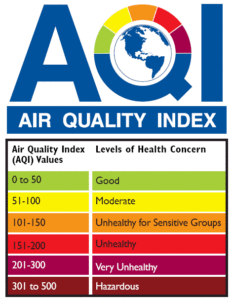Living with asthma or other lung problems isn’t easy and air pollution can worsen these symptoms. Philadelphia has many sources of air pollution, which often are invisible to the naked eye. Exhaust from cars and buses come from city traffic and the I-95 Highway corridor. Miles away, fine particulates from coal-fired power plants are carried by wind into air we breathe. The Philadelphia International Airport’s steady stream of airplanes constantly emits exhaust. The emissions from the oil refinery — another large source. All of these sources add up to degrade the quality of the air and depending on daily weather conditions, some days are worse than others are.
Philadelphia has 2-3 times higher asthma rates than the Commonwealth of Pennsylvania. Asthma is the third ranking cause of hospitalization among children and poor outdoor air quality causes asthma attacks. Poor air quality can cause heart attacks and other health problems too. Air pollution worsens asthma and breathing problems, and children dealing with these lung problems are more likely to miss school. This isn’t fun for anyone. Parents may need to take time off work to care for their sick child. Teachers will need to find time to communicate missed school materials to parents and children. A child may have lower self-esteem because of missed social opportunities during outdoor play. With 10.5 million school days missed every year due to asthma, it is easy to see how school achievement may be compromised.
So, how can you tell when the air is unhealthy? You can not always see air pollution. Invisible to the naked eye, ozone can cause an asthma attack. This is particularly worse during the hot summer months in the afternoon. In the cold weather, fine particulates which are also invisible are the main contributor to poor air quality and asthma.
Fortunately, the Environmental Protection Agency (EPA) tests the air every day and makes this information freely available at www.airnow.gov or www.airqualitypartnership.org . A color scale ranging from good (green) to purple (Hazardous) codes current outdoor air quality.
Signing up to receive free daily air quality alerts by email or text is easy, or simply visit one of the sites whenever you would like to know about current conditions. You can use this information to benefit anyone with asthma but it is particularly helpful for children. Children breathe faster, play outside and end up breathing more air than adults, so children have more exposure to pollution than adults. Simply remember if it is orange, red or purple— avoid outdoor play in the afternoon.






Thanks for sharing! actually you are right the risk of exposure to unhealthy levels of ground-level ozone is greatest during warmer months. Children, who often play outdoors
in warmer weather, are at higher risk.
Thanks for sharing! Actually people with existing lung disease may not be able to breathe as deeply or vigorously as they normally would. They may experience symptoms such as coughing and shortness of breath. Healthy people also may experience these effects,although they are unlikely to experience more serious effects.
I agree! Breathing well is something we tend to take for granted- until we get into trouble. The more contaminated the air we breathe is, the more quickly we succumb to illnesses and allergies. Even a subtle amount of indoor pollutants can raise our stress levels, and inhibit good health. Carrier Air Conditioners have an advanced dehumidifying component that makes breathing easier all year long.
Doesn’t UPenn monitor outdoor air quality? Could it share that info with the community? Sounds like a good way to help the community of West Philly…
UPenn does not formally monitor air pollution, although several groups have tried to assess the feasibility of doing so. I agree that it would be great if more measurements of local air pollution were available, but in the meantime, the Philadelphia Department of Public Health provides high quality measures of pollution in our area: https://www.phila.gov/services/mental-physical-health/environmental-health-hazards/air-quality/